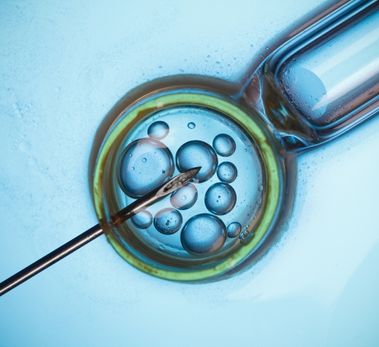Laparoscopy: Laparoscopy is recommended after an initial fertility examination in cases of pelvic pain or a history of pelvic disease. It helps diagnose and treat conditions like uterine fibroids, endometriosis, blocked tubes, ovarian cysts, adhesions, and other structural abnormalities.
Procedure: A laparoscope (telescope-like tube) is introduced in the abdominal cavity via a small incision in the navel or surrounding area under general anesthesia. Carbon dioxide gas is then passed into the abdominal cavity, thus dividing the internal organs from the cavity wall. This provides a clear view through the laparoscope and can also prevent injuries. A similar incision is made in your lower abdomen, and a small probe is inserted to manipulate the structures being evaluated. To identify a blockage, fluid is passed through the cervix, uterus, and fallopian tubes. If a problem is encountered, it can be corrected with the help of surgical instruments inserted via 1-2 additional incisions in your lower abdomen. Upon completion, the instruments are removed, the stomach is deflated, and the incisions are closed with sutures. Some procedures may require an open incision and not a laparoscope.
Risks and complications: Following laparoscopy, you may experience pain and bruises at the incision sites. You may also feel slight discomfort when the gas is introduced into the abdomen, which varies with the type and extent of the procedure. You can leave the same day and resume your activities in a few days.
Every procedure comes with its own risks; such risks with laparoscopy include skin irritation, infection, hematomas in the abdominal wall, and hardly any damage to internal organs and important blood vessels and nerves.
Hysteroscopy: Hysteroscopy is usually done to identify the cause of infertility, miscarriage, and abnormal uterine bleeding. Other imaging studies, such as ultrasound, generally precede it. A hysteroscopy can help identify anomalies in the uterine cavity, like fibroids, polyps, scarred areas, and congenital malformations. For the correction of certain anomalies, surgery may be performed during hysteroscopy. Before surgery, specific medications are given to prepare the uterus.
Procedure: The procedure is performed outpatiently and does not require any incisions. Initially, the cervical canal is widened temporarily with a series of dilators. A thin, long, lighted tube called a hysteroscope is inserted through the cervix to reach the uterus. The hysteroscope has narrow channels through which long surgical instruments are inserted to get inside the uterus and perform surgery.
To expand the uterine cavity and provide a clear view of the internal structure of the uterine cavity, saline fluid or carbon dioxide gas is introduced through the hysteroscope. Once the procedure is complete, a catheter may be left within the uterus. Medications to prevent infection and stimulate healing may be prescribed for some procedures.
Post-hysteroscopy, cramping, vaginal discharge, and bleeding for several days may be experienced, which is normal. You can resume your regular activities after 1 or 2 days.
Risks with hysteroscopy: Hysteroscopy, like other procedures, is rarely associated with certain complications, including perforation of the uterus, bleeding, and damage to surrounding organs. Some complications can occur due to the fluid used to expand the uterus.
Laparoscopy and hysteroscopy can aid in diagnosing and treating various gynecological disorders, including infertility. The procedures are minimally invasive, with fewer complications and less recovery time, allowing many procedures to be performed on an outpatient basis. Diagnosis and treatment are often performed during the same procedure, thus reducing the number of hospital visits.




